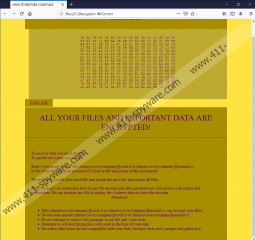C4H Ransomware Removal Guide
No one wants to be infected with ransomware, but sometimes programs like C4H Ransomware manage to enter our systems. Then, we have to focus hard on removing them, and looking for ways to restore our files. Although there is no public decryption tool available at the moment, you might still be able to restore the files encrypted by C4H Ransomware. Be sure to address a professional technician who could help you with the problem at hand. You should also learn more about ransomware in general, so you could avoid similar intruders in the future.
As far as this particular infection is concerned, we know that it’s not a lone wolf. C4H Ransomware comes from a group of similar infections, and it is another version of the GlobeImposter Ransomware. There are several editions of the same infection, but the problem here is that those different editions doesn’t share the same decryption key. Therefore, it means that if you got infected with C4H Ransomware, you will need an individual key to unlock your files.
Unfortunately, a public decryption key for this infection is not available, so you may have to depend on a file backup or sheer luck. This also shows how important it is to have file backups. It just means you should save copies of your files on an external hard drive or maybe in a cloud drive. The point is that you should keep your eggs in different baskets. It’s always a good idea to create copies of your files, just in case you might lose a device or something might happen to it. So, while it is a must in the days of ransomware pandemic, keeping a file backup is just a good practice in general.
C4H Ransomware doesn’t differ much from all the other ransomware programs that we have encountered before. It will also be distributed in a similar manner. That would mean that users download and install this malicious infection on their systems themselves. Of course, they are not aware of that, but they get duped into thinking that they are downloading an important document, and they must open it immediately. To put it simply, if you receive a file from an unknown sender, it’s best to remove that file or at least scan it before opening. If you fail to do that, you might have to deal with the likes of C4H Ransomware.
When this program enters the target system, it runs a thorough scan looking for all the file types it can encrypt. As far as we know, the program can easily encrypt almost every single personal file that you keep on your computer. It is also very likely that C4H Ransomware will skip system files because it needs your computer to function properly if it wants to collect the ransom payments. Here’s how it asks for those payments:
All your files and important data are encrypted!
To recovery data you need decryptor.
To get the decryptor you should:Send 1 test image or text file chinarecoverycompany@cock.li or chinarecoverycompany.@airmail.cc.
In the letter include your personal ID (look at the beginning of this document).
We will give you the decrypted file and assign the price for decryption all files.
While it might seem like contacting these criminals is the only way to get your files back, you should never do that. Remove C4H Ransomware following the manual removal guidelines below this description, and then explore other file recovery options. Again, if you have a file backup, you can just remove the encrypted files, and transfer the healthy copies into a clean computer. If not, you might want to address a professional who would help you with various file recovery options.
How to Delete C4H Ransomware
- Delete recent files from Desktop.
- Go to the Downloads folder and delete the most recent files.
- Press Win+R and type %TEMP%. Click OK.
- Delete the most recent files from the directory.
- Use SpyHunter to run a full system scan.
C4H Ransomware Screenshots:


